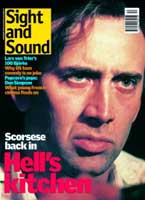
Following
UK 1998
Reviewed by David Thompson
Synopsis
Our synopses give away the plot in full, including surprise twists.
London, the present. Bill, a would-be writer, confesses to the police about his obsession with following complete strangers picked at random. Flashbacks reveal the following events.
When a suave young man called Cobb, whom Bill is following, confronts him, Bill is drawn into Cobb's obsession with casual burglary. Cobb's greatest thrill is uncovering victims' secrets. Bill visits a club and tries to chat up a blonde woman who warns him the manager is her jealous former lover. She tells him she was burgled the day before. Another day, Bill visits the blonde in her smart flat and they begin an affair. It was Bill and Cobb who burgled her flat, inspiring Bill to follow her. Unknown to Bill, Cobb is actually the blonde's current lover. Together they are framing Bill for the murder of an old lady during one of Cobb's burglaries.
While trying to retrieve some photographs the manager was using to blackmail the blonde, Bill kills a man with a hammer who interrupts him. Bill meets up with Cobb and tells him about the blonde, and Cobb responds with violence. The blonde tells Bill he's being framed by Cobb. Bill goes to the police. Later, Cobb tells her he's really working for the manager: his true plan is to frame Bill as her murderer by killing her with the hammer from the club. Bill learns from the police there was no old lady, the blonde has been found dead, and Cobb has removed all traces of his existence.
Review
In a time long ago when a Wim Wenders film created a sense of anticipation, some may recall the subtle playfulness of The American Friend (1977), which celebrated within its Patricia Highsmith murder plot the cinematic double entendres of 'framing' and 'set up'. A comparable spirit of gamesmanship permeates Christopher Nolan's remarkable debut film which, like Wenders' movie, occupies a precarious no-man's land between popular thriller and art film. Nolan may have drawn inspiration from performance artist Sophie Calle's infamous shadowing of strangers, or even her fictive equivalent in Paul Auster's novel Leviathan. But it's just a starting point for his own exhilarating maze of games and deceptions which keeps the spectator guessing throughout Following's relatively brief running time. Nolan keenly exploits cinema's narrative potential, busily flipping scenes so actions teasingly precede exposition in a way that hasn't been seen here since Nicolas Roeg's Bad Timing (1980).
Nolan's emotional aim may not be as high as Roeg's, but then his film doesn't pose the latter's painful, existential questions. Nor were Nolan's resources anything like as considerable. Shooting over weekends on 16mm black-and-white stock with what appears to be a minimum of lighting, Nolan shows a natural talent for a fluent handheld aesthetic. His unfamiliar cast acquit themselves well in a simple naturalistic style. Nothing distracts the viewer from the tantalising intrigue set up here, a precise justification of the lean (as opposed to Lean) quality of the film.
As such directors as Jacques Rivette (in Celine and Julie Go Boating, 1974) and James Toback (in Fingers, 1977) have demonstrated, there's a lot of mileage to be gained from having your main character follow a mysterious object of desire. But what they could accomplish in the irrepressibly cinematic Paris and New York, Nolan has managed to pull off in the usually intractable cityscape of London. Again, paucity of budget has presumably led him to reduce his locations to a series of sparsely populated cafés, clubs and flats, and from these Nolan has created a credible world of mysterious, disquieting corners with more than a tang of Godard's vision of Paris in Alphaville (1965).
To its credit, the film's gestures towards cerebral notions of narrative are not laboured. To continue the French references, Following echoes such Alain Robbe-Grillet films as Trans-Europ-Express (1966) in the way Bill's own writing constructs the plot in which he is enmeshed. If anything, the depiction of Bill's sweaty assaults on a Remington and his obsessive pursuit of material for stories parallels Mike Hodges and Paul Mayersberg's recent Croupier, another outsider film which took a similar delight in games and bluffs. Films like these, made in defiance of televisual and theatrical styles, occupy an awkward position in the prevailing consumer-led New British Cinema. Nolan has already gone on to make a film for HBO, apparently without compromising the storytelling dexterity displayed here. Will he be another talent allowed to wander far off the mean street of Wardour?
Credits
- Producers
- Christopher Nolan
- Jeremy Theobald
- Emma Thomas
- Screenplay
- Christopher Nolan
- Director of Photography
- Christopher Nolan
- Editors
- Gareth Heal
- Christopher Nolan
- Art Director
- Tristan Martin
- Music
- David Julyan
- ©Christopher Nolan
- Production Companies
- A Syncopy Films production
- Next Wave Films
- Special Make-up
- Miranda Gunning
- Sound
- Ivan Cornell
- David Lloyd
- David Julyan
- James Wheeler
- Fight Choreography
- Darren Ormandy
- Cast
- Jeremy Theobald
- the young man
- Alex Haw
- Cobb
- Lucy Russell
- the blonde
- John Nolan
- the policeman
- Dick Bradsell
- the bald guy
- Gillian El-Kadi
- home owner
- Jennifer Angel
- waitress
- Nicolas Carlotti
- barman
- Darren Ormandy
- accountant
- Guy Greenway
- Tassos Stevens
- heavies
- Tristan Martin
- man at bar
- Rebecca James
- woman at bar
- Paul Mason
- home owner's friend
- David Bovill
- home owner's husband
- John Bengue
- Ivan Cornell
- Jane Hunter
- Matthew Jones
- David Julyan
- David Lloyd
- Alberto Mattiussi
- Brendan Nolan
- Barbara Stepansky
- Emma Thomas
- Dianne Zack
- Certificate
- 15
- Distributor
- Alliance Releasing (UK)
- 6,282 feet
- 69 minutes 48 seconds
- In Black & White
